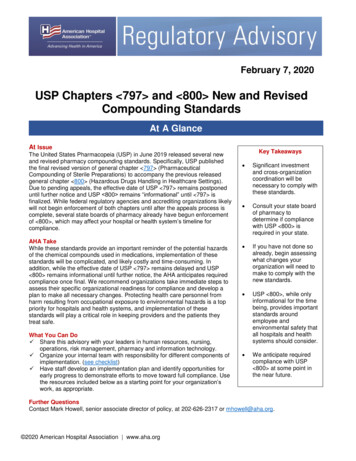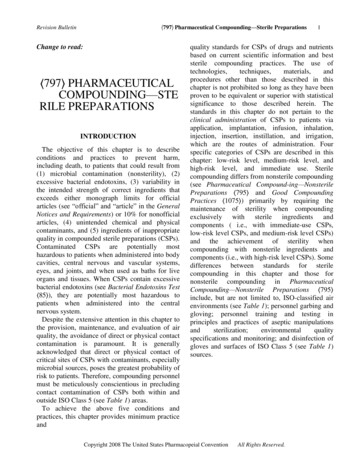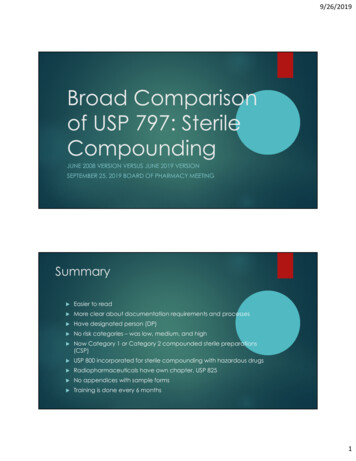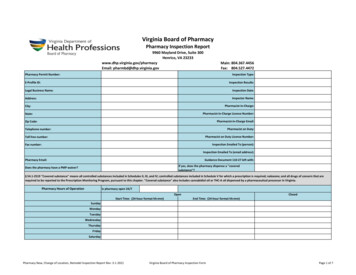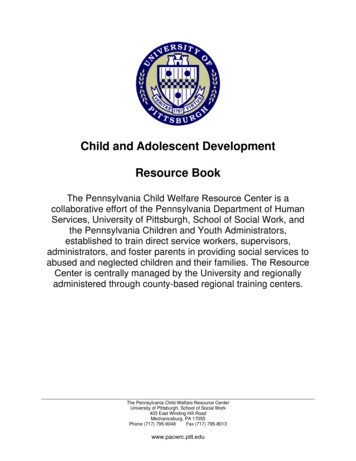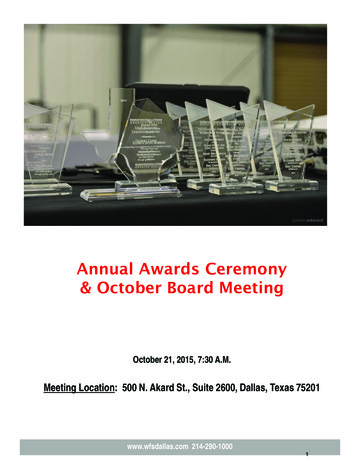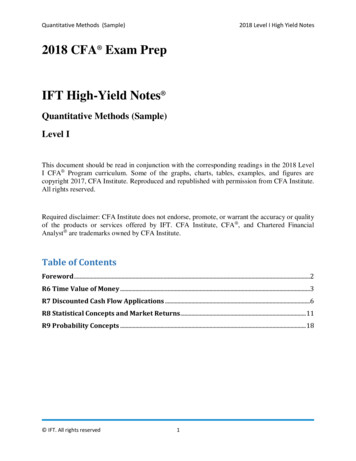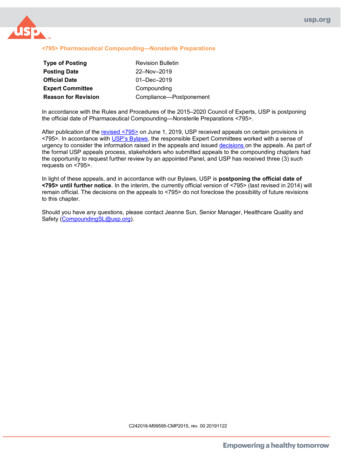
Transcription
795 Pharmaceutical Compounding—Nonsterile PreparationsType of PostingPosting DateOfficial DateExpert CommitteeReason for RevisionRevision ompliance—PostponementIn accordance with the Rules and Procedures of the 2015–2020 Council of Experts, USP is postponingthe official date of Pharmaceutical Compounding—Nonsterile Preparations 795 .After publication of the revised 795 on June 1, 2019, USP received appeals on certain provisions in 795 . In accordance with USP’s Bylaws, the responsible Expert Committees worked with a sense ofurgency to consider the information raised in the appeals and issued decisions on the appeals. As part ofthe formal USP appeals process, stakeholders who submitted appeals to the compounding chapters hadthe opportunity to request further review by an appointed Panel, and USP has received three (3) suchrequests on 795 .In light of these appeals, and in accordance with our Bylaws, USP is postponing the official date of 795 until further notice. In the interim, the currently official version of 795 (last revised in 2014) willremain official. The decisions on the appeals to 795 do not foreclose the possibility of future revisionsto this chapter.Should you have any questions, please contact Jeanne Sun, Senior Manager, Healthcare Quality andSafety (CompoundingSL@usp.org).C242016-M99595-CMP2015, rev. 00 20191122
á795ñ 1Revision BulletinOfficial December 1, 2019Change to read: á795ñ PHARMACEUTICAL COMPOUNDING—NONSTERILEPREPARATIONSThe official date for this chapter is postponed until further notice. When the official date is reestablished, the periodallowed for implementation will not be less than six months.1. INTRODUCTION AND SCOPE1.1 Scope2. PERSONNEL TRAINING AND EVALUATION3. PERSONAL HYGIENE AND GARBING3.1 Personnel Preparation3.2 Hand Hygiene3.3 Garb and Glove Requirements4. BUILDINGS AND FACILITIES4.1 Compounding Space4.2 Storage Area4.3 Water Sources5. CLEANING AND SANITIZING6. EQUIPMENT AND COMPONENTS6.1 Equipment6.2 Components7. MASTER FORMULATION AND COMPOUNDING RECORDS7.1 Creating Master Formulation Records7.2 Creating Compounding Records8. RELEASE INSPECTIONS9. LABELING10. ESTABLISHING BEYOND-USE DATES10.1 Terminology10.2 Parameters to Consider in Establishing a BUD10.3 Establishing a BUD for a CNSP10.4 CNSPs Requiring Shorter BUDs10.5 Extending BUDs for CNSPs11. SOPs12. QUALITY ASSURANCE AND QUALITY CONTROL13. CNSP PACKAGING AND TRANSPORTING13.1 Packaging of CNSPs13.2 Transporting CNSPs14. COMPLAINT HANDLING AND ADVERSE EVENT REPORTING14.1 Complaint Handling14.2 Adverse Event Reporting15. DOCUMENTATIONGLOSSARYAPPENDIX1. INTRODUCTION AND SCOPEThis chapter describes the minimum standards to be followed when preparing compounded nonsterile preparations (CNSPs)for humans and animals. For purposes of this chapter, nonsterile compounding is defined as combining, admixing, diluting,pooling, reconstituting other than as provided in the manufacturer’s labeling, or otherwise altering a drug or bulk drugsubstance to create a nonsterile medication.The requirements in this chapter must be followed to minimize harm, including death, to human and animal patients thatcould result from 1) excessive microbial contamination, 2) variability from the intended strength of correct ingredients (e.g., 10% of the labeled strength), 3) physical and chemical incompatibilities, 4) chemical and physical contaminants, and/or 5)use of ingredients of inappropriate quality.Handling of nonsterile hazardous drugs (HDs) must additionally comply with Hazardous Drugs—Handling in HealthcareSettings á800ñ. 2019 The United States Pharmacopeial Convention All Rights Reserved.C242016-M99595-CMP2015, rev. 00 20191122
2 á795ñRevision BulletinOfficial December 1, 20191.1 ScopeCNSPS SUBJECT TO THE REQUIREMENTS IN THIS CHAPTERCNSPs that must comply with this chapter include but are not limited to the following dosage forms: Solid oral preparations Liquid oral preparations Rectal preparations Vaginal preparations Topical preparations (i.e., creams, gels, ointments) Nasal and sinus preparations intended for local application (i.e., nasal sprays and nasal irrigation) Otic preparationsPRACTICES NOT SUBJECT TO THE REQUIREMENTS IN THIS CHAPTERThe following practices are not considered compounding and are not required to meet the requirements of this chapter:Administration: Preparation of a single dose for a single patient when administration will begin within 4 hours of beginningthe preparation is not required to meet the standards in this chapter.Nonsterile radiopharmaceuticals: Compounding of nonsterile radiopharmaceuticals is not required to meet the standards inthis chapter and is subject to the requirements in Radiopharmaceuticals—Preparation, Compounding, Dispensing, and Repackagingá825ñ.Reconstitution: Reconstitution of a conventionally manufactured nonsterile product in accordance with the directionscontained in the manufacturer approved labeling is not required to meet the standards in this chapter.Repackaging: Repackaging of conventionally manufactured drug products is not required to meet the standards in thischapter (see Good Repackaging Practices á1178ñ).Splitting tablets: Breaking or cutting a tablet into smaller portions is not required to meet the standards in this chapter.PERSONNEL AND SETTINGS AFFECTEDThis chapter applies to all persons who prepare CNSPs and all places where CNSPs are prepared. This includes but is notlimited to pharmacists, technicians, nurses, physicians, veterinarians, dentists, naturopaths, and chiropractors, in all placesincluding but not limited to pharmacies, hospitals and other healthcare institutions, patient treatment sites, and physicians’ orveterinarians’ practice sites.The compounding facility’s leadership and all personnel involved in preparing, storing, packaging, and transporting CNSPsare responsible for 1) ensuring that the applicable practices and quality standards in this chapter are continually and consistentlyapplied to their operations, and 2) proactively identifying and remedying potential problems within their operations. Personnelengaged in the compounding of CNSPs must also comply with laws and regulations of the applicable regulatory jurisdiction.The compounding facility must designate one or more individuals to be responsible and accountable for the performanceand operation of the facility and personnel for the preparation of CNSPs. The responsibilities of the designated person(s) includebut are not limited to: Overseeing a training program to ensure competency of personnel involved in compounding, handling, and preparingof CNSPs Selecting components Monitoring and observing compounding activities and taking immediate corrective action if deficient practices areobserved Ensuring that standard operating procedures (SOPs) are fully implemented. The designated person(s) must ensure thatfollow-up is carried out if problems, deviations, or errors are identified Establishing, monitoring, and documenting procedures for the handling and storage of CNSPs and/or components ofCNSPsThe designated person(s) must be identified in an SOP. If the compounding facility has only one person responsible for allof the compounding in the facility, then that person is the designated person.2. PERSONNEL TRAINING AND EVALUATIONAll personnel involved in the preparation and handling of CNSPs must be initially trained, must demonstrate competency,and must undergo refresher training every 12 months. Training and competency of personnel must be documented asdescribed in 15. Documentation.A designated person must oversee a training program that describes the required training, the frequency of training, andthe process for evaluating the competency of personnel involved in nonsterile compounding and handling of CNSPs. Thisprogram must equip personnel with knowledge and training in the required skills necessary to perform their assigned tasks.Before beginning to prepare CNSPs independently, all compounding personnel must complete training and be able todemonstrate proficiency in the principles and hands-on skills of nonsterile manipulations for the type of compounding they willbe performing. Proficiency must be demonstrated every 12 months in at least the following core competencies: Hand hygiene Garbing Cleaning and sanitizing 2019 The United States Pharmacopeial Convention All Rights Reserved.C242016-M99595-CMP2015, rev. 00 20191122
á795ñ 3Revision BulletinOfficial December 1, 2019 Handling and transporting components and CNSPs Measuring and mixing Proper use of equipment and devices selected to compound CNSPs Documentation of the compounding process (e.g., Master Formulation Records and Compounding Records)Steps in the training procedure must include the following: Read and understand this chapter, other applicable standards, and other relevant literature Understand and interpret Safety Data Sheets (SDSs) and, if applicable, Certificates of Analysis (COA) Read and understand procedures related to their compounding dutiesA designated person must oversee the training of personnel. Training and observation may be performed by the designatedperson(s) or an assigned trainer. Personnel must be observed and guided throughout the training process. The personnel willthen be expected to repeat the procedures independently, but under the direct supervision of the designated person(s)and/or trainer. Personnel will be permitted to perform the procedure without direct supervision only after independentlydemonstrating understanding and competency. Upon completion of the training program, the designated person(s) and/ortrainer must document that the personnel has been trained and successfully completed competency assessments (see 15.Documentation).In addition to the initial and annual competency training and evaluation described in this section, a designated person shouldmonitor and observe compounding activities and must take immediate corrective action if deficient practices are observed.SOPs must describe procedures for the monitoring and observing of compounding activities and personnel.If the facility has only one person in the compounding operation, that person must document that they have obtainedtraining and demonstrated competency, and they must comply with the other requirements of this chapter.3. PERSONAL HYGIENE AND GARBINGIndividuals entering the compounding area must maintain personal hygiene. Individuals must evaluate whether they havea personal risk of potentially contaminating the compounding environment and CNSP (e.g., personnel with rashes, recenttattoos or oozing sores, conjunctivitis, or active respiratory infection). Individuals must report these conditions to the designatedperson(s). The designated person(s) is responsible for evaluating whether these individuals should be excluded from workingin compounding areas before their conditions have resolved because of the risk of contaminating the CNSP and theenvironment.3.1 Personnel PreparationPersonnel engaged in compounding must maintain hand hygiene and maintain cleanliness required for the type ofcompounding performed.Before entering the compounding area, compounding personnel must remove any items that are not easily cleanable andthat might interfere with garbing. At a minimum, personnel must: Remove personal outer garments (e.g., bandanas, coats, hats, jackets) Remove all hand, wrist, and other exposed jewelry, including piercings that could interfere with the effectiveness of garbingor hand hygiene (e.g., watches, rings that may tear gloves) Remove earbuds or headphonesThe designated person(s) may permit accommodations as long as the quality of the environment and CNSP will not beaffected.3.2 Hand HygienePersonnel must perform hand hygiene when entering the compounding area to compound as described in Box 3-1. Alcoholhand sanitizers alone are not sufficient.Box 3-1. Hand Hygiene Procedures Wash hands and forearms up to the elbows with soap and water for at least 30 seconds. Dry hands and forearms to the elbows completely with disposable towels or wipers. Allow hands and forearms to dry thoroughly before donning gloves.To minimize the risk of cross-contaminating other CNSPs and contaminating other objects (e.g., pens and keyboards), glovesshould be wiped or replaced before beginning a CNSP with different components.All gloves must be inspected for holes, punctures, or tears and must be replaced immediately if such defects are detected.3.3 Garb and Glove RequirementsGloves must be worn for all compounding activities. Other garb (e.g., shoe covers, head and facial hair covers, face masks,gowns) should be worn as needed for the protection of personnel from chemical exposures and for prevention of preparationcontamination and must be appropriate for the type of compounding performed. The garbing requirements and frequency ofchanging the garb must be determined by the facility and documented in the facility’s SOPs.Garb must be stored in a manner that minimizes contamination (e.g., away from sinks to avoid splashing). Visibly soiled garbor garb with tears or punctures must be changed immediately. 2019 The United States Pharmacopeial Convention All Rights Reserved.C242016-M99595-CMP2015, rev. 00 20191122
4 á795ñRevision BulletinOfficial December 1, 2019If gowns are worn, they may be re-used if not soiled. If used, gloves, shoe covers, hair covers, facial hair covers, face masks,or head coverings may not be re-used and must be replaced with new ones. If used, non-disposable garb, such as goggles,should be cleaned and sanitized with 70% isopropyl alcohol before re-use.4. BUILDINGS AND FACILITIES4.1 Compounding SpaceSpace must be specifically designated for nonsterile compounding. The method of designation (e.g., visible perimeter) mustbe described in the facility’s SOP. Other activities must not be occurring in the space at the same time as compounding. Thecompounding space must be well-lighted and must be maintained in a clean, orderly, and sanitary condition, and in a goodstate of repair. Carpet is not allowed in the compounding space. Surfaces should be resistant to damage by cleaning andsanitizing agents.The space must provide for the orderly placement of equipment and materials to prevent mix-ups among components,containers, labels, in-process materials, and finished CNSPs. The space should be designed, arranged, and used in a way thatminimizes cross-contamination from non-compounding areas.4.2 Storage AreaCompounding personnel must monitor temperatures in storage area(s) either manually at least once daily on days that thefacility is open or by a continuous temperature recording device to determine whether the temperature remains within theappropriate range for the CNSPs or components. The results of the temperature readings must be documented on a temperaturelog or stored in the continuous temperature recording device, and must be retrievable. All temperature monitoring equipmentmust be calibrated or verified for accuracy as recommended by the manufacturer or every 12 months if not specified by themanufacturer.The compounding facility must adhere to SOPs to detect and prevent temperature excursions within storage area(s). Whenit is known that a CNSP or component has been exposed to temperatures either below or above the storage temperature limitsfor the CNSP or component, personnel must determine whether the CNSP or component integrity or quality has beencompromised and, if so, the CNSP or component must be discarded.All CNSPs, components, equipment, and containers must be stored off the floor and in a manner that prevents contaminationand permits inspection and cleaning of the storage area(s).4.3 Water SourcesA source of hot and cold water and an easily accessible sink must be available for compounding. The sink must be emptiedof all items unrelated to compounding and cleaned when visibly soiled before being used to clean any equipment used innonsterile compounding. The plumbing system must be free of defects that may contribute to the contamination of any CNSP.Purified Water (see Water for Pharmaceutical Purposes á1231ñ), distilled water, or reverse osmosis water should be used for rinsingequipment and utensils.5. CLEANING AND SANITIZINGCleaning and sanitizing of the surfaces in the nonsterile compounding area(s) must occur on a regular basis at the minimumfrequencies specified in Table 1 or, if compounding is not performed daily, cleaning and sanitizing must be completed beforeinitiating compounding. Cleaning and sanitizing must be repeated when spills occur and when surfaces are visibly soiled.Cleaning and sanitizing agents must be selected and used with consideration of compatibilities, effectiveness, and tominimize the potential to leave residues.If cleaning and sanitizing are performed as separate steps, cleaning must be performed first.Table 1. Minimum Frequency for Cleaning and Sanitizing Surfaces in Nonsterile Compounding Area(s)SiteWork surfacesMinimum Frequency At the beginning and end of each shift, after spills, and when surface contamination is known or suspected Clean and sanitize the work surfaces between compounding CNSPs withdifferent componentsFloorsDaily, after spills, and when surface contamination (e.g.,splashes) is known or suspectedWallsEvery 3 months, after spills, and when surfacecontamination (e.g., splashes) is known or suspectedCeilingsWhen visibly soiled and when surface contamination is known or suspectedStorage shelvingEvery 3 months, after spills, and when surfacecontamination (e.g., splashes) is known or suspected 2019 The United States Pharmacopeial Convention All Rights Reserved.C242016-M99595-CMP2015, rev. 00 20191122
á795ñ 5Revision BulletinOfficial December 1, 20196. EQUIPMENT AND COMPONENTS6.1 EquipmentThe equipment and supplies used for compounding a CNSP must be suitable for the specific compounding process.Equipment surfaces that contact components must not be reactive, additive, or sorptive, and must not alter the quality of theCNSPs. Disposable or dedicated equipment may be used to reduce the chance of bioburden and cross-contamination.Equipment must be stored in a manner to minimize the risk of contamination and must be located to facilitate its use,maintenance, and cleaning. Equipment and devices used in the compounding or testing of compounded preparations mustbe inspected prior to use and, if appropriate, verified for accuracy as recommended by the manufacturer and at the frequencyrecommended by the manufacturer, or at least every 12 months, whichever is more frequent. After compounding, theequipment must be cleaned to prevent cross-contamination of the next preparation.Weighing, measuring, or otherwise manipulating components that could generate airborne chemical particles [e.g., activepharmaceutical ingredients (APIs), added substances, conventionally manufactured products] must be assessed to determineif these activities must be performed in closed system processing device to reduce the potential exposure to personnel orcontamination of the facility or CNSPs. Examples of closed system processing devices include containment ventilated enclosures(CVEs), biological safety cabinets (BSCs), or single-use containment glove bags. The process evaluation must be carried out inaccordance with the facility SOP and the assessment must be documented.If a BSC or CVE is used, it must be certified every 12 months according to requirements such as the current ControlledEnvironment Testing Association (CETA), NSF International, or American Society of Heating, Refrigerating, and Air-ConditioningEngineers (ASHRAE) guidelines, or other laws and regulations of the applicable regulatory jurisdiction.If a CVE or other non-disposable device is used, it must be cleaned as described in Table 2.Table 2. Minimum Frequency for Cleaning and Sanitizing Equipment in Nonsterile Compounding Area(s)SiteMinimum FrequencyCVE At the beginning and end of each shift, after spills, and when surface contamination is known or suspected Clean and sanitize the horizontal work surface of the CVE between compounding CNSPs with different componentsOther devices and equipment used in compounding operations Before first use and thereafter in accordance with the manufacturer’s recommendations If no recommendation is available, after compounding CNSPs with different components6.2 ComponentsThe compounding facility must have written SOPs for the selection and inventory control of all components from receipt touse in a CNSP.SDSs must be readily accessible to all personnel working with APIs and added substances located in the compounding facility.Personnel must be instructed on how to retrieve and interpret needed information.COMPONENT SELECTIONA designated person must be responsible for selecting components to be used in compounding.APIs: Must comply with the criteria in the USP–NF monograph, if one exists Must have a COA that includes the specifications and test results and shows that the API meets the specifications In the United States, must be obtained from an FDA-registered facility Outside of the United States, must comply with laws and regulations of the applicable regulatory jurisdictionAll components other than APIs: Should be accompanied by a COA that verifies that the component meets the criteria in the USP–NF monograph, if oneexists, and any additional specifications for the component In the United States, should be obtained from an FDA-registered facility If it cannot be obtained from an FDA-registered facility, the designated person(s) must select a component that issuitable for the intended use Outside of the United States, must comply with laws and regulations of the applicable regulatory jurisdictionCOMPONENT RECEIPTUpon receipt of components other than conventionally manufactured products, the COA must be reviewed to ensure thatthe component has met the acceptance criteria in a USP-NF monograph, if one exists. For components other than conventionallymanufactured products, information including the receipt date, quantity received, supplier name, lot number, expiration date,and results of any in-house or third-party testing performed must be documented.The date of receipt by the compounding facility must be clearly and indelibly marked on each component package that lacksa vendor expiration date. Packages of components (i.e., API and added substances) that lack a vendor’s expiration date mustnot be used by the compounding facility after 3 years from the date of receipt. A shorter expiration date must be assigned 2019 The United States Pharmacopeial Convention All Rights Reserved.C242016-M99595-CMP2015, rev. 00 20191122
6 á795ñRevision BulletinOfficial December 1, 2019according to Pharmaceutical Compounding—Sterile Preparations á797ñ, 9.3 Components, Component Receipt if the samecomponent container is also used in sterile compounding or if the ingredient is known to be susceptible to degradation.For each use, the lot must be examined for evidence of deterioration and other aspects of unacceptable quality. Onceremoved from the original container, components not used in compounding (e.g., excess after weighing) should be discardedand not returned to the original container to minimize the risk of contaminating the original container.Any component found to be of unacceptable quality must be promptly rejected, clearly labeled as rejected, and segregatedfrom active stock to prevent use before appropriate disposal. Any other lots of that component from that vendor must beexamined to determine whether the other lots have the same defect.COMPONENT EVALUATION BEFORE USEBefore use, compounding personnel must visually re-inspect all components. Packages must be inspected to detect containerbreaks, looseness of the cap or closure, or deviation from the expected appearance or texture of the contents that might haveoccurred during storage.Compounding personnel must ascertain before use that components are of the correct identity based on the labeling andhave been stored under required conditions in the facility.If the correct identity, strength, purity, and quality of components intended for preparation of CNSPs cannot be confirmed(e.g., containers with damaged or incomplete labeling), they must be immediately rejected. If they are not immediatelydiscarded, they must be clearly labeled as rejected, and segregated to prevent their use before disposal.COMPONENT HANDLINGAll components must be handled in accordance with the manufacturer’s instructions or per laws and regulations of theapplicable regulatory jurisdiction. The handling must minimize the risk of contamination, mix-ups, and deterioration (e.g., lossof identity, strength, purity, and quality).COMPONENT SPILL AND DISPOSALThe facility must maintain chemical hazard and disposal information (e.g., SDSs) and must review and update its chemicalhazard and disposal information every 12 months. The chemical hazard and disposal information (e.g., SDSs) must be madeaccessible to compounding personnel.The facility must have an SOP for the management of nonhazardous component spills and disposal. If required by the SOP,these activities must be documented and corrective action taken.The facility must have a readily accessible spill kit in the compounding area. The contents of the spill kit should be affixed tothe packaging of the spill kit if not readily visible on the manufacturer’s label.All personnel who may be required to remediate a spill must receive training in spill management of chemicals used andstored at the compounding facility. Refresher training must be conducted every 12 months and documented for all personnelwho may be required to clean up a spill.Waste must be disposed of in accordance to laws and regulations of the applicable regulatory jurisdiction. The disposal ofcomponents must comply with laws and regulations of the applicable regulatory jurisdiction. For information on the handlingof HDs, see á800ñ.7. MASTER FORMULATION AND COMPOUNDING RECORDS7.1 Creating Master Formulation RecordsA Master Formulation Record is a detailed record of procedures that describes how the CNSP is to be prepared. A MasterFormulation Record must be created for each unique formulation of a CNSP. CNSPs are prepared according to the MasterFormulation Record and the preparation information is documented on a Compounding Record (see 7.2 Creating CompoundingRecords). Any changes or alterations to the Master Formulation Record must be approved and documented according to thefacility’s SOP. Box 7-1 lists the information that must be included in a Master Formulation Record.Box 7-1. Master Formulation RecordsA Master Formulation Record must include at least the following information: Name, strength or activity, and dosage form of the CNSP Identities and amounts of all components If applicable, relevant characteristics of components (e.g., particle size, salt form, purity grade, solubility) Container–closure system(s) Complete instructions for preparing the CNSP, including equipment, supplies, and a description of the compounding steps Physical description of the final CNSP Assigned beyond-use date (BUD) and storage requirements Reference source to support the assigned BUD and storage requirements If applicable, calculations to determine and verify quantities and/or concentrations of components and strength or activity of API Labeling requirements (e.g., shake well) Quality control (QC) procedures (e.g., pH testing, visual inspection) and expected results Other information needed to describe the compounding process and ensure repeatability (e.g., adjusting pH, temperature) 2019 The United States Pharmacopeial Convention All Rights Reserved.C242016-M99595-CMP2015, rev. 00 20191122
á795ñ 7Revision BulletinOfficial December 1, 20197.2 Creating Compounding RecordsA Compounding Record documents the compounding of each CNSP. A Compounding Record must be created for all CNSPs.Each Compounding Record must be reviewed for completeness before the CNSP is released. The identifier of the personcompleting the review and the date of review must be documented on the Compounding Record. The Compounding Recordmust permit traceability of all components in the case of a recall or known quality issue. The Master Formulation Record canbe used as the basis for preparing the Compounding Record. For example, a copy of the Master Formulation Record can bemade that contains spaces to record the information needed to complete the Compounding Record. Box 7-2 lists theinformation that must be included in a Compounding Record.Box 7-2. Compounding RecordsCompounding Records must include at least the following information: Name, strength or activity, and dosage form of the CNSP Date and time of preparation of the CNSP Assigned internal identification number (e.g., prescription, order, or lot number) A method to identify the individuals involved in the compounding process and verifying the final CNSP Name, vendor or manufacturer, lot number, and expiration date of each component Weight or measurement of each component Total quantity compounded Assigned BUD and storage requirements If applicable, calculations to determine and verify quantities and/or concentrations of components and strength or activity of API Physical description of the final CNSP Results of quality control procedures (e.g., pH testing, visual inspection) Master Formulation Record reference for the CNSP8. RELEASE INSPECTIONSAt the completion of compounding and before release and dispensing, the CNSP must be visually inspected to determinewhether the physical appearance is as expected. Inspections must also confirm that the CNSP and its labeling match theCompounding Record and the prescription or medication order. Some CNSPs, as noted in their Master Formulation Record,also must be visually checked for certain characteristics (e.g., emulsi
Handling and transporting components and CNSPs Measuring and mixing Proper use of equipment and devices selected to compound CNSPs Documentation of the compounding process (e.g., Master Formulation Records and Compounding Records)

